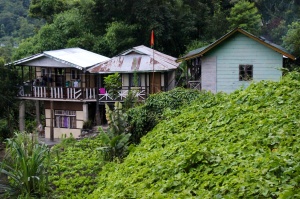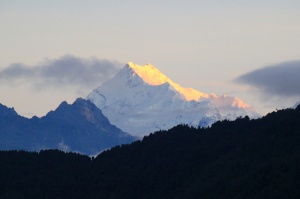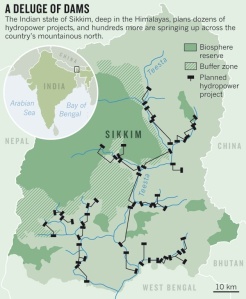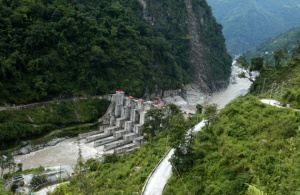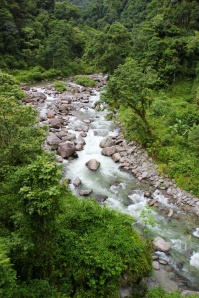On July 21, our group left Gangtok, Sikkim and headed towards the north to explore Dzongu. We settled in the village of Hee-Gyathang in Lower Dzongu. Dzongu is a protected area in Sikkim, reserved for the endangered indigenous Lepcha population. The Lepcha people are Sikkim’s earliest inhabitants who believe that they were created from the snow of Mt. Kangchenjunga. In Hee-Gyathang we moved into a cozy and rustic homestay owned by Tenzing Lepcha.
Tenzing Lepcha’s homestay in Dzongu
Tenzing is an innovative leader in his community. He’s dedicated to teaching his people how to become more self-sufficient and not to rely completely on the government, like many Sikkimese people do. Though he is a humble man with a permanent smile on his face, he carries the heavy burden of a self-proclaimed “freedom fighter”. As a freedom fighter he is protesting against the many Indian government-funded hydroelectric damming projects developing across Dzongu and the entire state of Sikkim.
In America, we view hydroelectric damming as a green alternative energy source. In Dzongu, the local Lepcha community is protesting the damming because of its devastating environmental and cultural impacts. When I asked Tenzing why he protests the dams, he explained how the Lepcha people believe that when they die, their soul swims up the Rongyong River, more commonly known as the Teesta, to reach Mt. Kangchenjunga. The dams represent possible obstacles that Lepcha souls may face while trying to find their way to the holy mountain.
Mt. Kangchenjunga
Though the damming projects are supported by Sikkim’s Chief Minister, they are funded by the Indian government, who are desperately trying to find ways to increase their electricity input. Since these dams are supported by the Indian Central Government, the people who work to build these dams are outsiders, typically from the plains. Tenzing is concerned about the effect such an influx of outsiders could have on his community. He’s especially concerned about the increased levels of violence and sexually transmitted diseases they bring to this remote area. The entire Lepcha culture in Dzongu could be at risk of being submerged in a sea of outsiders.
In terms of environmental impacts, many of the dam projects planned for the Teesta River are in earthquake prone zones, therefore increasing the chances of landslides. According to a Nature.com article written on the Sikkimese damming projects, if India implemented all 32 hydroelectric damming projects that have been approved so far, one-third of Sikkim’s tree biodiversity would decrease by 2025. In addition, 22 plants species would become extinct along with 7 vertebrate groups.
Map of proposed hydroelectric dams in Sikkim
Source: http://www.himalayanconnections.org
Thankfully Tenzing’s protests have helped delay the production of new dams in his area. Tenzing is an important member of Affected Citizens of Teesta, or ACT, a group of Dzongu community members that work together to peacefully protest the developing dams. Since the Lepcha people are Buddhist, their main form of protest is hunger strikes. On June 20th, 2007, Tenzing participated in his first hunger strike against the dams. He went on a 63-day indefinite hunger strike in protest to one of the developing dams. After 63 days, the Chief Minister of Sikkim gave in. Again in March 2008, Tenzing went on another hunger strike, this time refusing to eat for 93 days.
Tenzing is still fighting developing dams to this day. He fights to preserve Dzongu’s environment, maintain the Lepcha culture and heritage, and prevent the many social and health issues that could occur with the construction of the hydroelectric dams. His intentions are pure and good, but of course there are always ways to complicate issues in Sikkim.
Run-of-the-River hydroelectric dam on the Teesta River
Source: http://www.himalayanconnections.org
The development of the hydroelectric dams in Sikkim would severely damage the natural environment and potentially corrupt the indigenous culture, so why is India developing these dams in the first place? According to the Nature.com article, India is the world’s third largest emitter of carbon dioxide, and most of these emissions come from burning coal to produce electricity. Carbon dioxide emissions are estimated to double by 2030 if India does not implement more sustainable energy sourcing methods. To combat this issue, India has planned to add another 110,000 megawatts of hydroelectric capacity by 2025, an eightfold increase.
For India, hydroelectric dams represent a start towards using more sustainable energy. For Sikkim, hydroelectric dams represent an end to their extremely biodiverse environment and dwindling indigenous culture. So who’s in the right? Does India refuse to establish dams in Sikkim to preserve their environment, but risk contributing to the increasing levels of carbon dioxide in the global atmosphere? Does Sikkim allow the dams to be built to support India’s push towards alternative energy but risk destroying their own environment and culture? Each question comes with a cost, and of course there are no easy answers.
Teesta, or Rongyong, River
For more information on protests against Sikkim’s dams, read the Nature.com article entitled “Flood of protest hits Indian dams” at http://www.nature.com/news/flood-of-protest-hits-Indian-dams-1.11932
Lindsay Vanderhoogt ’14
